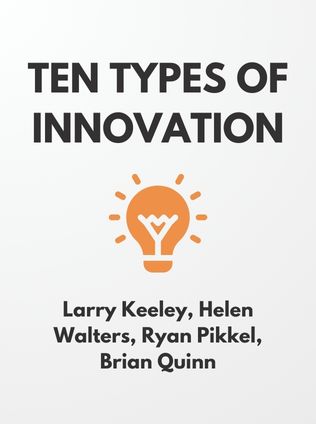
Ten Types of Innovation
The Discipline of Building Breakthroughs
By Larry Keeley, Helen Walters, Ryan Pikkel, and Brian Quinn
Published 01/2013
About the Author
Larry Keeley, a renowned strategist and co-founder of the Doblin Innovation Firm, has dedicated his career to the pursuit of understanding and mastering innovation. With a background steeped in strategic consulting and innovation management, Keeley has been at the forefront of guiding companies through complex innovation challenges. His work, alongside that of his colleagues Ryan Pikkel, Brian Quinn, and Helen Walters, has been instrumental in shaping how organizations approach innovation today. Through their collective efforts, they have distilled decades of experience into the book Ten Types of Innovation, offering a roadmap for companies seeking to innovate effectively and sustainably.
Main Idea
The central thesis of Ten Types of Innovation revolves around a fundamental insight: most innovation projects fail not because of a lack of creativity or effort, but because they focus on too few types of innovation or on the wrong types altogether. Keeley and his team argue that successful innovation requires a holistic approach that incorporates multiple types of innovation simultaneously. By understanding and leveraging the ten distinct types of innovation, companies can create breakthroughs that are not only novel but also difficult for competitors to replicate, thereby driving sustainable growth and profitability.
Table of Contents
- Introduction to Innovation
- The Ten Types of Innovation Framework
- Product-Related Innovations
- Company-Related Innovations
- Perception-Related Innovations
- Common Pitfalls in Innovation Projects
- Strategies for Successful Innovation
- Case Studies and Practical Applications
- Conclusion: The Future of Innovation
Introduction to Innovation
Innovation is often hailed as the key to success in today's fast-paced business environment. Yet, despite its importance, many innovation efforts fall short of their goals. Keeley and his co-authors begin by exploring the reasons behind these failures. They argue that a narrow focus on product innovation alone is insufficient. Instead, innovation must be viewed more broadly, encompassing not just the product but also the processes, business models, and customer experiences that surround it.
In the words of the authors:
"Innovation is anything that is new or novel in its context and that contributes to making a product or service viable and profitable." – Larry Keeley
This definition underscores the idea that innovation is not just about inventing new products or technologies. It is about creating value in ways that differentiate a company from its competitors and resonate with customers. Keeley’s framework identifies ten distinct types of innovation, grouped into three broad categories: product-related innovations, company-related innovations, and perception-related innovations. Each type offers a different pathway to creating value, and the key to successful innovation lies in strategically combining multiple types to achieve a unique and sustainable competitive advantage.
The Ten Types of Innovation Framework
The book's core framework categorizes innovations into ten types, which are further divided into three overarching categories:
Sign up for FREE and get access to 1,400+ books summaries.
You May Also Like
Rich Dad Poor Dad
What the Rich Teach Their Kids About Money - That the Poor and Middle Class Do Not!
By Robert T. KiyosakiFreakonomics
A Rogue Economist Explores the Hidden Side of Everything
By Steven D. Levitt and Stephen J. DubnerThe Lean Startup
How Today's Entrepreneurs Use Continuous Innovation to Create Radically Successful Businesses
By Eric RiesWho Moved My Cheese?
An Amazing Way to Deal with Change in Your Work and in Your Life
By Spencer Johnson, M.D.Factfulness
Ten Reasons We're Wrong About the World – and Why Things Are Better Than You Think
By Hans RoslingMake Your Bed
Little Things That Can Change Your Life...And Maybe the World
By William H. McRaven



















